The Samsung Galaxy S6 and S6 edge Review
by Joshua Ho on April 17, 2015 9:00 AM EST- Posted in
- Smartphones
- Samsung
- Mobile
- Galaxy S6
- Galaxy S6 Edge
NAND Performance: The First UFS Phone
Storage performance is often a critical area for user performance, as applications cannot be cached in RAM at every possible moment. Camera performance is also often limited by storage performance as RAM buffers can only do so much to maintain performance before it’s necessary to commit photos to non-volatile storage.
However due to the memory hierarchy to some extent, storage performance is often hard to notice once it’s at a point where things are “good enough”. Unfortunately, in some cases we can see OEMs failing to include sufficiently performant solid-state storage, which can be a major pain point in the user experience when random read/write performance is low enough that there are noticeable IO pauses as the system has to wait for data to be loaded from storage.
The Samsung Galaxy S6 family is the first shipping implementation of UFS (Universal Flash Storage) 2.0 standard, which makes the internal storage model less like an SD card in nature. When comparing the eMMC 5.1 standard to the UFS 2.0 standard, we see a move from a the 400 MB/s maximum of the eMMC 5.1 standard with HS400 physical link interface to MIPI M-PHY, which allows for a theoretical maximum of around 720 MB/s and should be more efficient in transmitting data than the current eMMC standard. In addition, UFS makes it possible to do full duplex communication, which means that reads and writes can happen simultaneously. There's also a command queue, which helps to avoid inefficiencies that could arise from waiting for commands once a command has been processed by the storage controller, and utilizes the SCSI protocol to facilitate these new features at the interface level.
As for the Galaxy S6 itself, the UFS implementation Samsung is using is Samsung developed. Samsung's current implementation only supports up to 300 MB/s (or 2.4 Gbps) transfer rates as a theoretical maximum, so from an interface perspective it's still not reaching the full capabilities of the standard. Though even at a cap of 300MB/sec, it still stands to be a significant improvement over typical eMMC solutions.
Finally, on a technical note, the 32GB models are of the model KLUBG4G1BD-E0B1 with a maximum queue depth of 16.
In order to test storage performance, we use Androbench with some custom settings to get a reasonable idea of performance in this area, although this test isn’t an exhaustive examination of storage performance by any means.
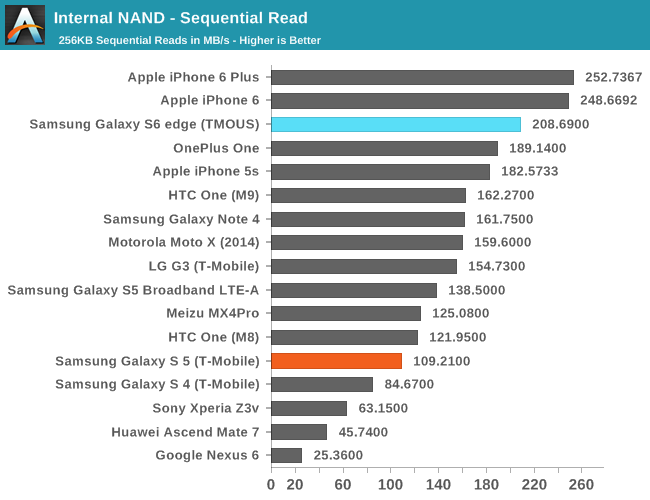
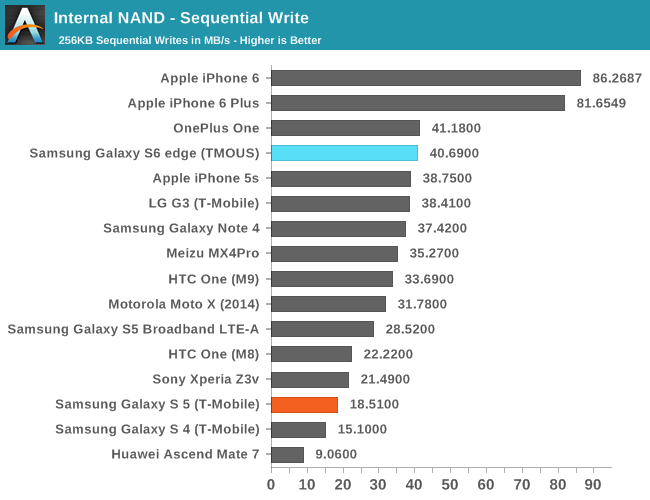
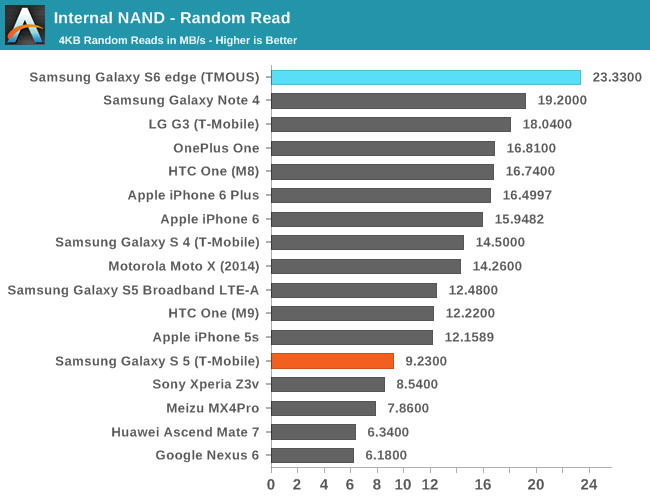
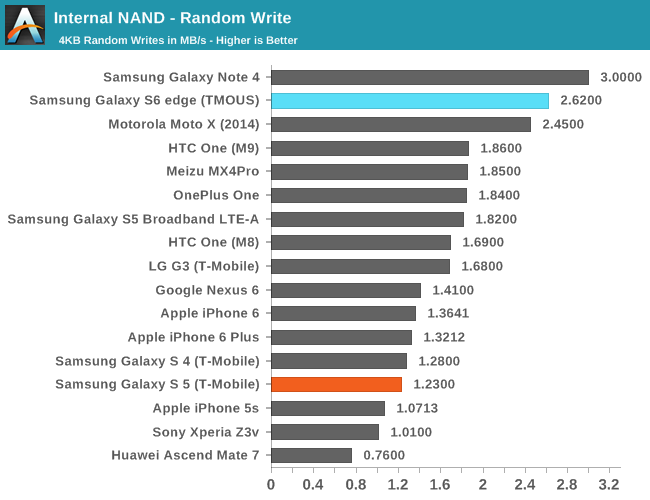
The Galaxy S6 performs rather impressively in our standard storage test, but not as fast as one might have hoped. This is due to the nature of the Androbench 3.6 test, which only tests a single IO thread, which won’t use the UFS storage of the Galaxy S6 to its full extent. In order to see the kind of difference that UFS really makes, I ran the same test again on Androbench 4.x, which does support multiple IO threads. However, as our iOS storage test and Androbench 3.6 don’t support more than a single IO thread we will continue to present both results for now.
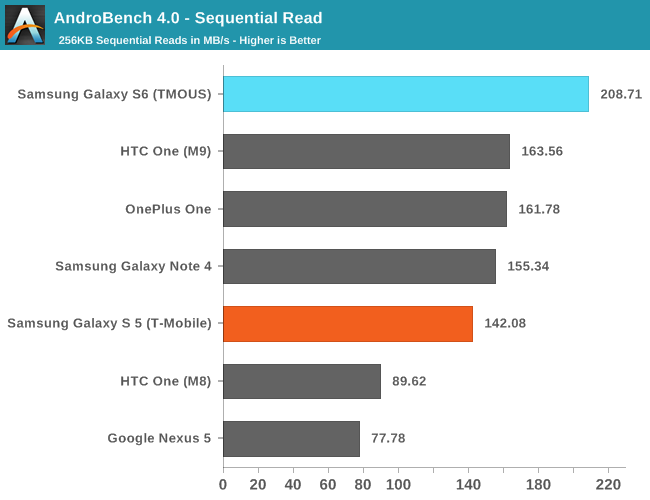
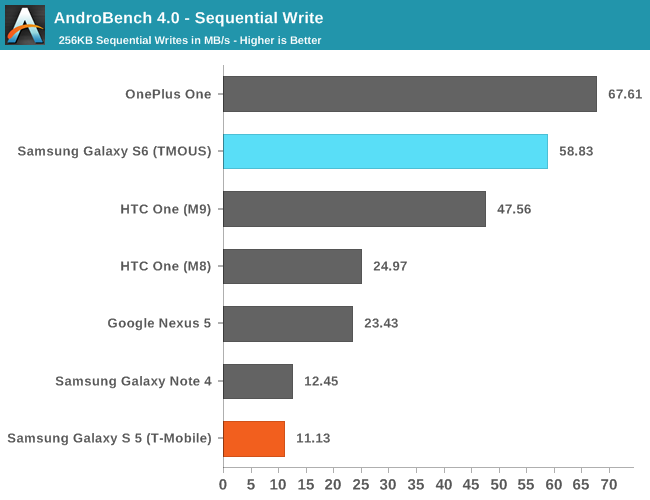
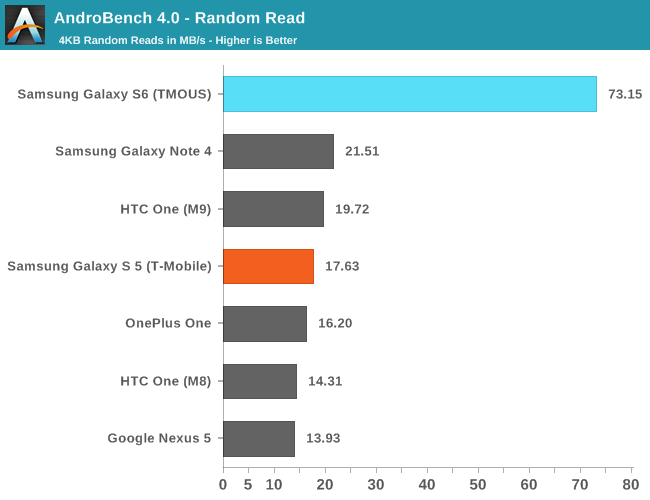
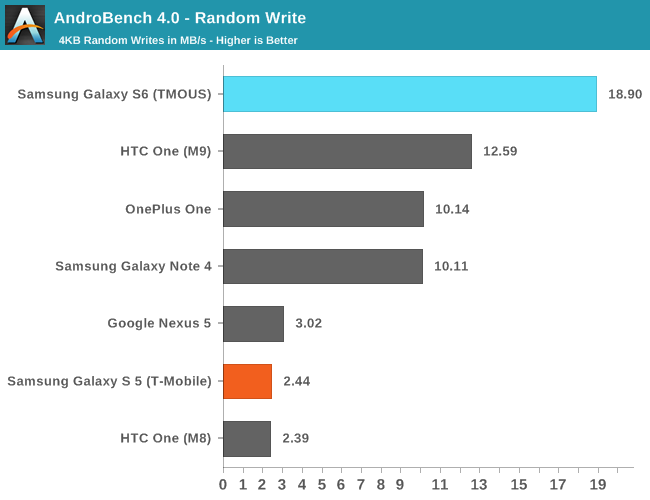
Overall, there are some immense benefits in storage performance here, especially in random IO performance. The Galaxy S6 has some of the fastest storage available in a phone today as far as I can tell given that this is basically a pure MLC solution, and shouldn’t have any real issue with storage performance holding back the rest of the phone over the course of 1-3 years as long as a reasonable amount of free space is kept to allow efficient storage management.


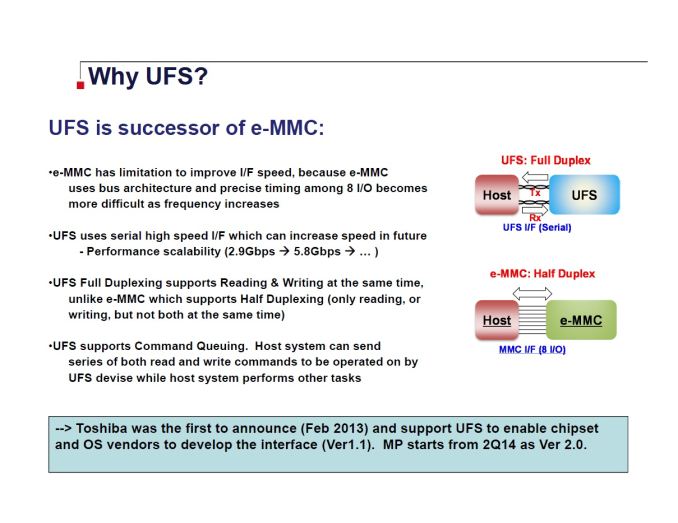








306 Comments
View All Comments
JoshHo - Friday, April 17, 2015 - link
Something similar to the APx582 would be necessary to test 3.5mm output accurately, and a good SPL meter would help with speaker quality although I'm not sure results for the latter would be comparable between editors.IsthatyouBevis - Friday, April 17, 2015 - link
Wow, that camera comparison is really poorly done. Trying to compare what you seem to think are the 2 best cameras (iPhone 6+ and S6) was extremely difficult. Why do you present the galleries in such a way as it is impossible to determine which picture to click to see which phone and why can't we see them clearly in the same page, instead of the click fest you force us to go through? Surely there is a better way to demonstrate this?johnnohj - Friday, April 17, 2015 - link
1. Were these photos taken with Auto-HDR enabled? If I am not mistaken, both the iPhone and S6 ship with Auto-HDR turned on by default. Those impressive low-light photos Samsung showed at the unveiling were taken with Auto-HDR enabled.2. Can immersive mode (full-screen) be disabled on Samsung apps like Calculator and S-Planner?
3. Were there any problems with RAM management like in this video https://youtu.be/hUw9PUlFUF0?t=1m32s where the S6 keeps killing apps in the background? It could explain the poor battery life some people are experiencing as apps would have to be killed and reloaded all day.
4. Can heads-up notifications be disabled?
5. I wish there was a way to test standby battery usage. It is something android phones have always been poor at compared to iPhones. How about a test where the x most popular apps (like Facebook, Gmail, WhatsApp, Instagram, Twitter with the same accounts, sync enabled) are installed to multiple test devices on the same wifi network and the battery usage is measured after x hours?
6. Why does Samsung still include the Quick Connect and S-Finder buttons in the notification slider? It's so annoying, and there is no way to disable them without root (except on a few US carrier versions).
Hrel - Friday, April 17, 2015 - link
No sd card is pretty bad, but being Samsung is worse.khujin - Friday, April 17, 2015 - link
I just tested GS6 edge 64GB and Androbench4.0 result is 320MB/s(seq. read), 140MB/s(seq. write) with default setting. And another website GS6 performance review it the same as mine. please check the UFS test.JoshHo - Friday, April 17, 2015 - link
The default sequential test does 32MB sequential reads which is wildly unrealistic at best. As shown in the storage performance section we test using 256KB reads and writes for sequential performance.heartinpiece - Saturday, April 18, 2015 - link
Nice review Joshua! I don't see any Ipad Air 2 performances in the performance charts (although they are constantly referenced...) could you check on the graphs?Peichen - Saturday, April 18, 2015 - link
Seems like there are only 2 company making real flagship phones now: Apple and Samsung. To achieve this status, buying off-the-shelf parts are no longer good enough. You need to custom order parts and optimize the software specifically for the parts. From SoC, memory, screen to camera, everything is custom ordered to achieve the best quality. Off-the-shelf phones like M9 and Nexus 6 are relegated to good $500ish phone status.On the other hand, it is sad to see Samsung abandon all its believes and completely adapted Apple design and philosophy. Nano-SIM, downward speaker, simplified camera UI, fingerprint magnet back, home-button scanner and the abandonment of colorful UI and screen tone. Samsung users always love the punchy screen color. What are they going to say now the school is color corrected like iPhone display?
Peichen - Saturday, April 18, 2015 - link
screen*Impulses - Saturday, April 18, 2015 - link
Maybe, I think LG or Sony could still step up to the plate... Sony's got a whole bunch of outside issues threatening the future of it's phone division tho, and probably their budget. Which is a shame because they made the only SMALL flagship phone last year in the Z3c.The bigger issue at play might be that a good chunk of the market is now complacent with their $500 or less also-rans, and another sizeable chunk is just buying outgoing models instead of the current hotness. Otherwise the SGS5 should've sold even better than the 4, and it had every right to based on hardware alone.
I'm part of that segment tbh, huge Android fan, initially went thru three successive HTC phones year after year... Not really feeling that upgrade bug anymore, at all. I'd like better battery life than what my N5 offers, and/or water resistance, can live without either for now.
My phone isn't my main camera so I'm an exception there but I don't think the average buyer even realizes what makes for a better camera or reads AT to find out.